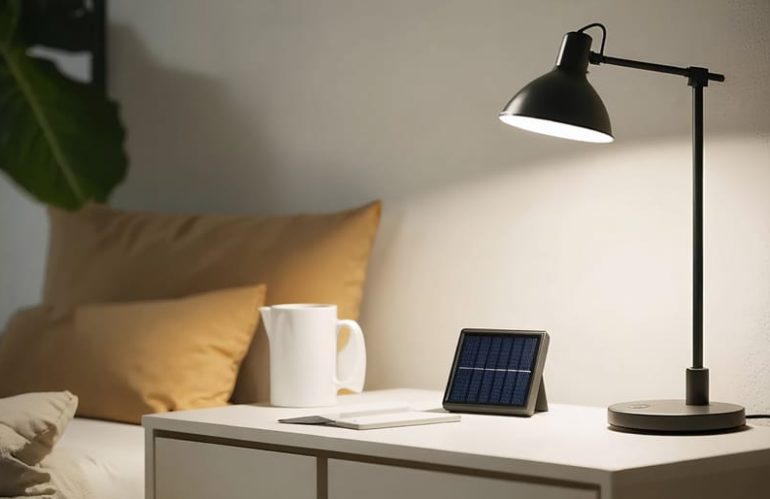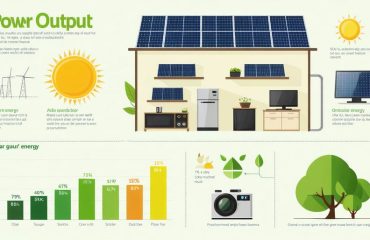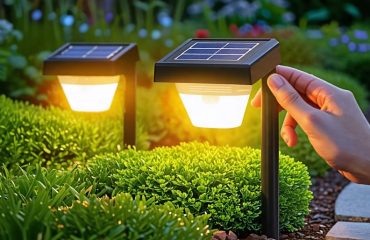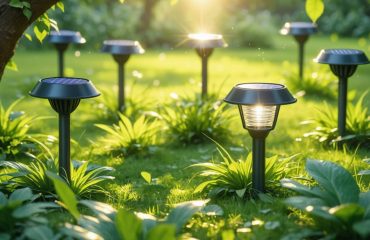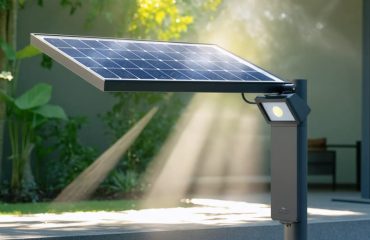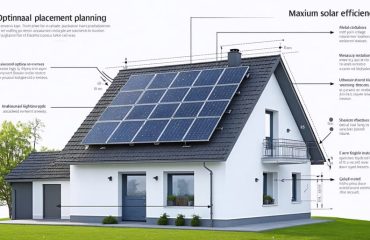Power up your solar lights even during cloudy seasons using proven indoor charging alternatives. While sunlight remains the most efficient charging method, several effective options ensure your solar-powered fixtures stay bright when natural light is scarce. Position solar panels under bright LED or fluorescent lights, maintaining a 12-inch distance to simulate sunlight’s intensity. Alternatively, use a standard household light bulb (60-100 watts) positioned 20 inches from the panel for 8-10 hours to achieve a meaningful charge. For optimal results, clean the solar panels thoroughly before indoor charging and ensure they’re angled directly toward the artificial light source. These methods, while not as powerful as direct sunlight, provide practical solutions for maintaining illuminated outdoor spaces during overcast weather, short winter days, or when solar lights are installed in permanently shaded areas. Understanding these alternatives helps maximize your solar lighting investment year-round, regardless of weather conditions.
Why Solar Lights with On/Off Switches Are Different
Solar lights with on/off switches offer a distinct advantage when it comes to alternative charging methods. Unlike their always-on counterparts, these lights give you complete control over the charging process, making them more versatile and efficient to charge indoors.
The primary benefit lies in their ability to preserve battery life during the charging process. When charging using artificial light or other alternative methods, you can keep the switch in the “off” position, ensuring all incoming energy is directed solely to charging the battery rather than simultaneously powering the light.
This feature is particularly valuable during winter months or extended periods of cloudy weather. You can charge the lights during the day using artificial light sources while preventing unnecessary battery drain. Once fully charged, simply flip the switch to “on” and place the lights outside for immediate illumination.
The switch also helps extend the overall lifespan of your solar lights by preventing overcharging and allowing you to regulate charging cycles more effectively. This makes them more cost-effective in the long run and ideal for regions with variable sunlight conditions.
For optimal results, always ensure the switch is in the “off” position during indoor charging and only turn it on once the light is ready for use outdoors.
Safe Indoor Charging Methods
Using LED Light Bulbs
LED light bulbs offer a practical alternative for charging your solar lights when sunlight is scarce. Position your solar lights approximately 12 inches away from a bright LED bulb, ensuring the solar panel faces directly toward the light source. For optimal results, use LED bulbs with a color temperature between 5000K and 6500K, which most closely mimics natural daylight.
While charging, place the solar light on a stable surface and avoid any objects that might block the light. A desk lamp or adjustable fixture works well for this purpose, allowing you to angle the light perfectly. Keep in mind that LED charging typically takes longer than natural sunlight – expect about 10-12 hours for a full charge.
To maximize efficiency, clean the solar panel before charging and ensure your LED bulb is at least 2000-3000 lumens. While this method isn’t as effective as direct sunlight, it’s a reliable backup solution during cloudy days or winter months. Remember to turn off the solar light while charging to prevent unnecessary battery drain and ensure the best charging results.
Incandescent Light Method
Incandescent light bulbs can effectively charge your solar lights when sunlight isn’t available. Position your solar panel approximately 20 inches away from a 60-100 watt incandescent bulb for optimal charging. While this method isn’t as efficient as natural sunlight, it can provide enough energy to power your lights for several hours.
Remember to keep safety in mind when using this approach. Never place the solar panel too close to the bulb, as this could damage the panel or create a fire hazard. The bulb will generate heat, so ensure proper ventilation and avoid contact with flammable materials.
For best results, angle the solar panel directly towards the light source, just as you would position it towards the sun outdoors. While charging times will vary depending on your specific solar light model and the bulb’s wattage, expect to leave the setup in place for 10-12 hours to achieve a full charge.
This method works in a pinch, but keep in mind that it will increase your electricity consumption. Consider using it only when natural charging options aren’t available.
Window Placement Strategy
Strategic window placement is crucial for maximizing indoor charging of solar lights. Position your lights near south-facing windows, which receive the most indirect sunlight throughout the day. For optimal results, place them on windowsills or small tables within 6-12 inches of the glass. Remove screens if possible, as they can reduce light transmission by up to 30%. Consider using reflective surfaces like aluminum foil or white paper behind the lights to bounce more light onto the solar panels. During winter months, when sunlight is limited, prioritize placing lights near windows that receive the most ambient light during peak daylight hours, typically between 10 AM and 2 PM. Keep windows clean and free from obstruction to ensure maximum light penetration.
Charging Time and Efficiency Tips
Expected Charging Times
Different charging methods will require varying amounts of time to fully power your solar lights. When using artificial light sources, expect LED bulbs (60-watt equivalent) to take 8-10 hours for a complete charge. Incandescent bulbs may charge lights faster, typically within 6-8 hours, due to their higher heat output, though they’re less energy-efficient overall.
For indirect sunlight charging methods, such as placing lights near bright windows, expect charging times of 10-12 hours on cloudy days. USB charging adapters, when compatible, usually provide the fastest charging option, requiring just 4-6 hours for a full charge.
Keep in mind that charging efficiency can vary based on several factors, including the age of your solar lights, battery capacity, and the intensity of your charging source. Older solar lights may take longer to reach full charge. For best results, allow extra charging time during your first few attempts to gauge the optimal duration for your specific lights and chosen charging method.
Remember that while alternative charging methods work well in a pinch, they generally take longer than direct sunlight exposure, which typically requires just 4-6 hours of bright sun for optimal charging.
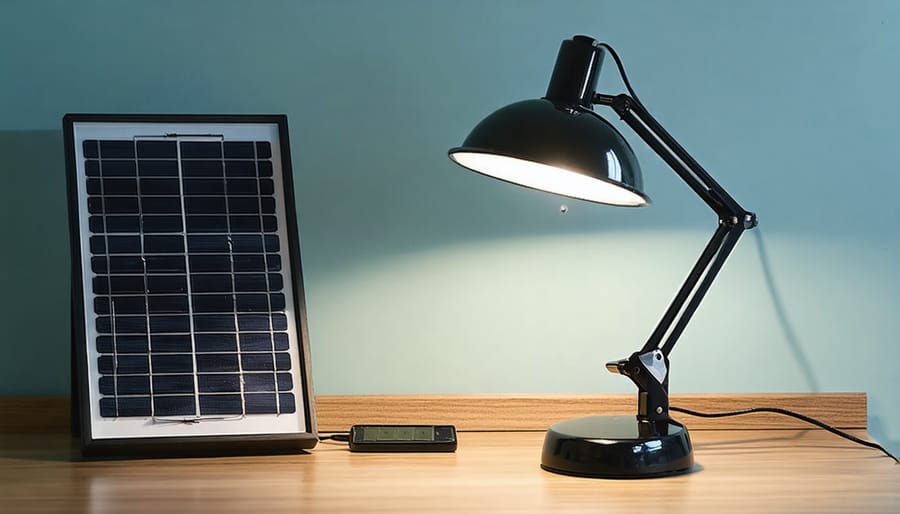
Optimizing Charge Storage
To maximize charging efficiency and extend the life of your solar lights, proper battery maintenance is essential. Start by cleaning the solar panels regularly with a soft, damp cloth to remove dust and debris that can reduce charging capacity. When storing your lights, always ensure the batteries are at least partially charged, as completely depleted batteries can suffer permanent damage.
Consider replacing old batteries with high-quality NiMH rechargeable batteries, which typically offer better performance and longevity than standard options. Keep your solar lights in a cool, dry place when not in use, as extreme temperatures can affect battery performance and lifespan.
To maintain optimal charging cycles, avoid leaving your solar lights in charging mode for excessive periods. A good practice is to charge them for 8-10 hours at a time, then allow them to discharge naturally through normal use. During winter months, rotate your lights between indoor charging and outdoor use to prevent battery strain from constant low-light conditions.
Remember to check the battery contacts periodically for corrosion and clean them gently with a cotton swab if needed. These simple maintenance steps will help ensure your solar lights remain bright and efficient throughout the year.
Common Mistakes to Avoid
When charging your solar lights without direct sunlight, it’s crucial to avoid common mistakes that could damage your equipment or reduce its efficiency. First, never attempt to charge solar lights using high-powered artificial light sources like powerful LED flashlights or heat lamps, as these can damage the sensitive photovoltaic cells. Understanding basic solar light functionality will help you avoid these pitfalls.
Avoid placing solar lights too close to artificial light sources, as this can cause overheating. Keep a minimum distance of 12 inches between the light source and your solar panel. Don’t leave your solar lights charging indefinitely under artificial light, as this can reduce battery life. Instead, stick to recommended charging times of 8-10 hours.
Another common mistake is using incompatible charging methods. Never attempt to charge solar lights by connecting them directly to electrical outlets or batteries, as this can permanently damage the internal components. Also, avoid charging solar lights behind glass windows, as most windows filter out the UV rays necessary for efficient charging.
When using LED bulbs for charging, don’t choose bulbs that are too dim. While excessive brightness can damage the panels, insufficient light won’t charge the batteries effectively. Select bulbs between 2,000 and 3,000 lumens for optimal results.
Lastly, don’t forget to clean your solar panels regularly. Dust and debris can significantly reduce charging efficiency, even when using artificial light sources. A simple wipe with a soft, damp cloth can make a substantial difference in charging performance.
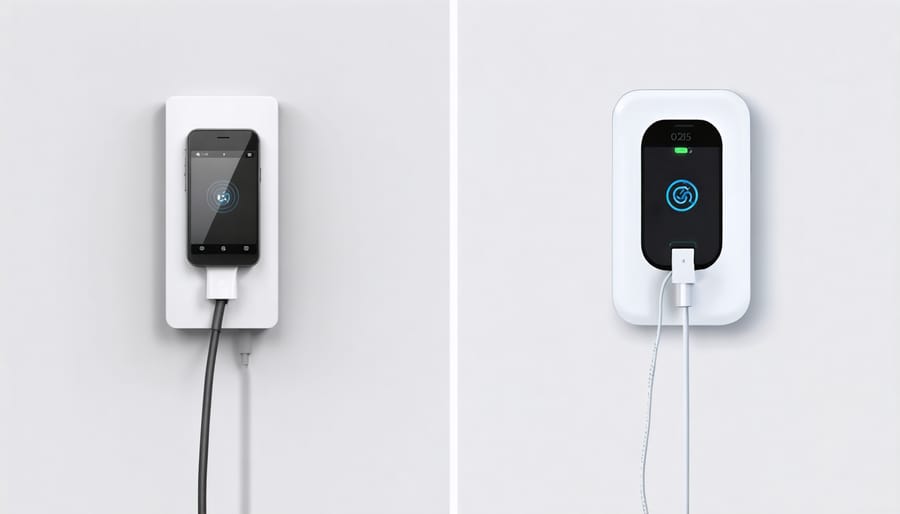
As we’ve explored throughout this guide, charging solar lights without direct sunlight is not only possible but can be achieved through several practical methods. Whether you choose to use artificial light sources, LED bulbs, or even indoor lighting, the key is to ensure your solar panels receive adequate light exposure for efficient charging. By implementing these alternative charging solutions, you can maintain bright, functional solar lighting even during cloudy days or winter months.
Remember that while these methods are effective, they should be viewed as supplementary solutions to natural sunlight. Whenever possible, position your solar lights to maximize exposure to natural daylight, as this remains the most efficient charging method. Regular maintenance, proper positioning, and keeping your solar panels clean will also help optimize charging performance regardless of the light source you use.
As we move towards a more sustainable future, solar lighting continues to play a crucial role in reducing our environmental impact and energy costs. By understanding and implementing these alternative charging methods, you’re not just solving a practical problem – you’re contributing to a more sustainable lifestyle. Consider incorporating these techniques into your regular routine, especially during seasons with limited sunlight, to ensure your solar lights remain a reliable and eco-friendly lighting solution throughout the year.
Let’s continue to embrace solar technology while being smart about how we adapt it to our needs, ensuring we get the most out of our sustainable lighting investments.

